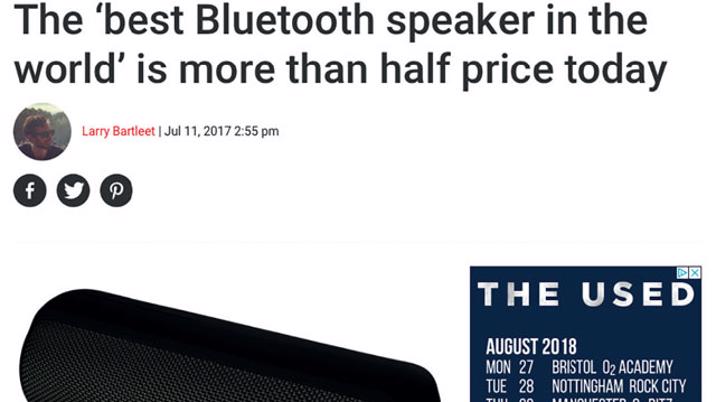
The free at the point of consumption online publishing model was built on the idea that display advertising could build a profitable business for print and digital publishers, giving consumers free access to content as a value exchange for serving them relevant advertising. Over time, the technology delivering these adverts has evolved. The UK publishing industry has moved into programmatic advertising, private market places, network sells, cookies tracking users across the web, 3rd party advertising and a host of technologies that consumers showed little interest or saw much benefit in.
As more and more people became publishers and the volume of advertising available to potentially buy increased, publishers moved into creative media as an effective way of engaging with consumers. This leveraged the content creator’s insight and expertise into a given subject as a way of delivering a branded message to readers that can be entertaining and informative and is now a significant alternative revenue stream across UK publishing.
The latest supplementary revenue stream to come to market is affiliate revenues offered to partners by retailers. This model sees retailers such as Amazon, John Lewis, eBay and many high street brands offering a commission to publishers who send customers to their online stores.
This is not a case of just putting some relevant shopping links to retailers in your news stories; you will need to consider what you are publishing, the people creating the content and the people who are consuming that content and what their intent is.
Affiliate revenue works best on content that has the potential for developing purchase intent.
What type of content works for affiliates?
Affiliate revenue works best on content that has the potential for developing purchase intent. On NME.com, we have a partnership with the ticket retailer TickX. This partnership came about because it makes sense that if people are reading about an artist who is touring (and has tickets available), then they might be interested in purchasing tickets. So, when we display dates and prices for the venues they are going to play, we are reducing the friction and making things better for the user. We are helping them with a potential need.
Likewise, if a user is researching a product on trustedreviews.com and a five-star review of a new phone validates the user’s decision that it is the right one for them, it feels like a service if we can make buying it easier. By finding them the best possible price for that phone, on a contract that suits them and displaying that price at the right point in time – they are more likely to click on the affiliate link and make a purchase. The Eagle product that the TI Media team has built, searches numerous retailers and returns the best price, saving the consumer time and allowing them to buy, confident that they have chosen the best product and are paying the best price.
However, if a user is consuming content with no purchase intent, the affiliate opportunity doesn’t present itself. So, if a reader is browsing a piece of content on NME.com and reading about why 16-year olds deserve to vote in the general election, we don’t try to get them to go and shop because an affiliate link would be an intrusion.
We must give our users a good experience and help them buy from trusted retailers.
How do I get my team creating affiliate content?
Paul Cunliffe, affiliates director at TI Media explains, “First there is the education piece, to make sure that everyone knows what the affiliate model is; how it works and how successful it can be. It’s important to show that, at its most successful, it’s about helping a user to complete a journey they came to the site for in the first place. If I read a review of an iPad and then want to buy it, isn’t it a good thing if a publisher helps me find the best deal available today? Alongside this, I often talk about trust – how we must give our users a good experience and help them buy from trusted retailers. A bad shopping experience reflects badly on the site, so we strive to do right by our users.”
Paul goes on to explain: “Following this, we then work very closely with editorial. We create agreed guidelines to operate within – when to link out to retailers and when not to. We agreed what the links should look like, where they should be placed in the content, how frequently they should appear, etc.”
“With this agreed, we were then able to push on with proving the commercial opportunity without doing anything to the content that editorial would disagree with. This quickly demonstrated that we could generate meaningful revenue but also showed that the value of content isn’t just in its page views (and ad impressions). It’s also about how effective the content is at helping a user complete their buying journey, if indeed, that is the purpose of the content. Page views remain important to ad business but an article can have a small audience but be extremely effective at helping a user buy the product they’re interested in.”
At TI Media, we’ve found that in niche sections of trustedreviews.com, such as the home PC component tests, an article on PC components can have relatively small scale compared to a review of the latest iPhone. But a much greater percentage of the people researching PC motherboards convert to purchase when they read the expert’s detailed tests on which one is best. Again, price comparisons delivered at the time a user is ready to or has made a decision to buy are key to conversion.
One way to breed affiliate success in the content team is to foster competition and reward success.
Share the data
The next key element is feeding back to editorial. What works, what doesn’t. What products are being bought and in what volumes. This is useful data that can feed into the content strategy and it tells us a lot about the audience. It might demonstrate that a brand we don’t write about is actually really popular, or that users are more interested in lower priced products than the higher priced ones we tend to write about. Sharing this data makes sure that editorial are part of the journey. They can quickly see the effectiveness of the content they’ve created because affiliates offer visibility of this in a way that other commercial models don’t.
This gets really exciting when it happens in real time, during large retail events such as Amazon Prime day or Black Friday. On these occasions, we found that even an audience that isn’t arriving on the site with purchase intent, is open to consuming content that benefits them. This led to the introduction of deal posts made up of shoppable content. If a retailer is offering a deal on a general product such as a bluetooth speaker that could appeal to anyone who likes listening to music and a price point that excites the audience, then the appetite for that is huge. During Black Friday last year, NME’s audience bought thousands of pounds worth of bluetooth speakers simply because we highlighted that the best speaker on the market was half price and available at a saving of £70. The people purchasing didn’t arrive on NME thinking, “Today is the day I’m going to buy a new speaker”, but the fact that NME made them aware of such a good deal felt like a service and not us pushing them into doing something that would benefit us. It was a win / win situation; it was the most popular content on the site that day as the audience shared it with their friends. It delivered great reach for the brand, great affiliate revenue and fitted with NME’s mission to bring people the best of popular culture (except this time is was through shopping, not words, pictures, audio or video).
Another convincer, and always popular with editorial, is that when the affiliate model really starts to motor, then you can look at taking other more obtrusive ad formats off the page and potentially improve the user experience. Editorial don’t like to see their content covered in ads so if there’s a chance of improving the user experience, then that’s a real positive for them.
A final tip to breed affiliate success in the content team is to foster competition and reward success. As you feedback on what’s selling and the best ways to promote it on owned & operated and across social, the content creators become proud of their success. In the same way that authors who create the most popular content in terms of users and sessions are proud of the popularity of what they create, the authors of the highest performing affiliate pieces should be celebrated and rewarded with prizes. These are self-funding, but I can confirm that if you tell an editorial team that the one who sells the most merchandise via the NME merch store will get a Nintendo Switch, they work much harder at their shoppable content.
Top tips for affiliate success
- Consider the benefit to the consumer: why are you putting an affiliate link on that section of an article?
- Does the article have purchase intent: is the link relevant to the journey the user is on?
- Get the content creators invested in the success of your affiliate business.
- Share as much information about what was and what wasn’t bought with the people who are influencing the buyers.
- Reward success when you find a format that works.












